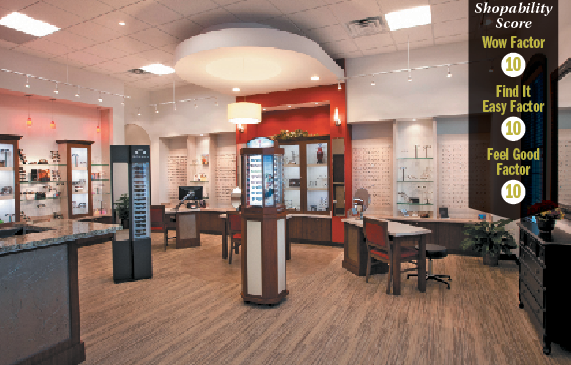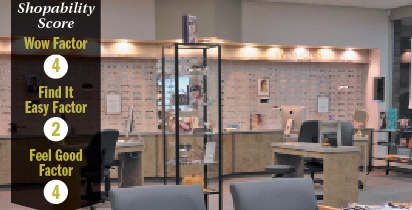Article
How ‘shopable’ is your dispensary?
An optical dispensary designed for maximum shopability is a powerful marketing tool.
Take-home
An optical dispensary designed for maximum shopability is a powerful marketing tool.

Wright
“People spend money where and when they feel good.” -Walt Disney
Competition for eyewear dollars is more intense than ever-online frame sales are increasing, insurance reimbursements are shrinking, discounters seem to be everywhere. How to combat these trends and win more sales in the dispensary? Increase the "shopability" of the optical shop and increase the capture rate, up the average sale, and gain higher optical profits.
Score your practice for the following three key “shoppable” factors on a scale of 1 to 10, with 1 being poor, 5 being average, and 10 being outstanding. Better yet, survey patients on these factors before they leave the practice. Find out what they really think of your optical dispensary. Improve the factors with below-average scores and optical revenue and profits will improve, too.
1. The ‘wow’ factor: The overall appearance of the optical dispensary has high visual appeal.

Does your optical dispensary “wow” patients the moment they see it? At the very least, does it look clean, up to date, and uncluttered? Are frames and other products the focal point of the shopping experience? Does the environment send a message to patients that their eyewear needs and desires will be satisfied here?
If it’s been more than 7 years since your optical dispensary opened or has undergone any remodeling, the score is likely to be less than 5.
Light it up
One quick fix that can help is to improve lighting. Major advances in lighting technology over the past few years now make it possible to replace the lamps in older track lights with bright, energy-efficient LED lamps. Just be sure to buy the brightest “retro-fit” LED lamps with pure white light and good color-rendering properties.
An optical dispensary that looks old, dingy, and tired is a real turn-off for the patients you most want to keep. Patients who want fashionable, high-quality frames and are willing to pay a premium for the right style will walk if they are not convinced your optical dispensary is worth a look. The patients who do stay will expect bargain prices and deals, because the atmosphere does nothing to persuade them otherwise.
Stand out from the crowd
With all choices people have today, an optical retailer cannot succeed by being just average any more. The look and feel of the retail area has to have a magnetic, intriguing quality to it that makes patients excited to explore the frame selection and confident that the optical dispensary has something that’s “just right” for them.

The immediate visual appeal of the optical dispensary will either make them stay or chase them away.
If the optical dispensary as been let go for too long and the office is hopelessly outdated, then nothing short of a major remodel will reverse a lackluster sales trend. If a majority of patients do stay and shop, then the optical dispensary is on the right track. If patients spontaneously start shopping for frames rather than sit down in the waiting area, then the optical dispensary is better than average in visual appeal.
2. The find-it-easy factor: Products are organized by easy-to-understand categories and displayed in ways that communicate their value.
This is where shopability fails miserably in many practices. One glance at the optical dispensary must convince patients they can find the price, the fashion, and the quality they want.
Too often, frames are simply hung on multiple frame boards in a boring sea of sameness, making it impossible for the patient to distinguish one brand from another or one price category from another. Why is this frame $100 and the one right next to it $250? The frames all end up looking the same, and patients become overwhelmed by too many choices.
These same patients would be willing to spend more for a brand they know, but if that brand is not presented as a collection and identified with a show card or logo plaque, they never notice it and do not buy it.
Do not plaster displays with big price signs unless the aim is to attract low-price bargain hunters. Trying to compete on price is a losing strategy for most practices. A better strategy is to offer superior customer service with a selection of good to high-quality frame brands different from the competition-brands that cannot be bought online.
Get organized
In a well-designed optical dispensary, each price category is displayed in a different way to communicate price, quality level, and value of the product. Typically, frames in a practice will be 80% middle priced, 10% will be low end, and 10% high end.
No-frills frame boards and acrylic frame rods are good for low-end frames. Middle-priced frames can be displayed on a combination of frame boards for non-branded and lesser-known brands, plus glass shelves for better-known brands, where frames are grouped together as a collection.
High-end frames must be displayed like jewelry in brightly lit showcases, always clearly identified by brand or designer name. Patients perceive the value and quality of frames by how they are presented-the higher the price, the more open space they need around them to emphasize their exclusivity and high quality.
Shelves offer much-needed flexibility for displaying brands and grouping different numbers of frames together. Frames displayed on shelves require a variety of risers and frame holders to bring them up off the shelf and present them at an attractive angle. Displays should be kept as simple as possible with a limited number of display props allowed. Less is more when it comes to optical display.
3. The feel-good factor: The shopping experience is convenient and enjoyable.
The final key measure of shopability is how good patients feel from start to finish. Convenience is part of the feel-good quality of any shopping experience, but it is patients’ definition of convenience that counts. Convenience could mean easy parking and easy payment options or, for time-crunched executives and working mothers, it could mean that the practice strictly adheres to an on-time schedule with minimal waiting time.
Making patients feel good during the time they spend in the optical dispensary requires an investment of both time and money. First, envision the experience you want to give them, then plan the physical design to foster that experience at every turn. Consider how to create a multilayered experience that involves all of the senses. The more senses involved, the more memorable the experience.
- Vision: The colors, materials, and lighting of the interior make a huge impact on how good people feel in the space. Work with a professional optical designer to create the right atmosphere that sends the right message to patients.
- Hearing: Background music or the soothing sound of flowing water can add to the mood of the optical dispensary and also help to disguise conversations. Employees who speak clearly in patients’ native tongue and are able to explain complex health or technical issues in simple terms can add immeasurably to patients’ satisfaction with their shopping experience.
- Smell: Experiment with various ways to add a subtle scent to the retail area. Some practices test different scents and settle on one to be their signature scent. Tie a good experience to a certain scent and it triggers the memory of that good experience when the person encounters that scent again. Bakeries are not the only businesses that can use scent to influence customer behavior positively.
- Taste: Offer refreshments to make patients feel welcome and pampered-cold water, hot beverages, mints, candies, for example.
- Touch: Everything the patient touches during an office visit-door knobs, reception desk/countertop, pens, clipboards, chairs, tables, sinks, eyewear, cases, accessory products, take-home bags-communicates a message about the quality of services and products. For a “Medicaid-to-millionaires” practice that serves a wide range of income groups, it is essential to use finish materials that are good-looking and practical, but not ostentatious or intimidating to lower-income groups. For a practice that targets strictly middle-to-upper-income patients, it is essential to use higher-end materials that convey the impression of high quality and high fashion that those patients are expecting.
Do not underestimate the positive power of touch when used in a professional manner to convey caring, compassion, or appreciation from physicians and staff members to patients and family members.
Making the shopping experience special and enjoyable gives the practice a tremendous advantage that no online retailer can match. Buying online is a limited two-dimensional, search-and-see experience compared with the full three-dimensional, touch-feel-and-try experience. An optical dispensary designed for maximum shopability is a powerful marketing tool. It will predispose patients to shop your optical dispensary, buy their frames from you, and return to your practice again and again.
Barbara W. Wright, CID, is president of Barbara Wright Design, Smyrna, TN. Readers may contact her at 888/422-0361 or Barbara@bwdesign.info.
Newsletter
Don’t miss out—get Ophthalmology Times updates on the latest clinical advancements and expert interviews, straight to your inbox.




